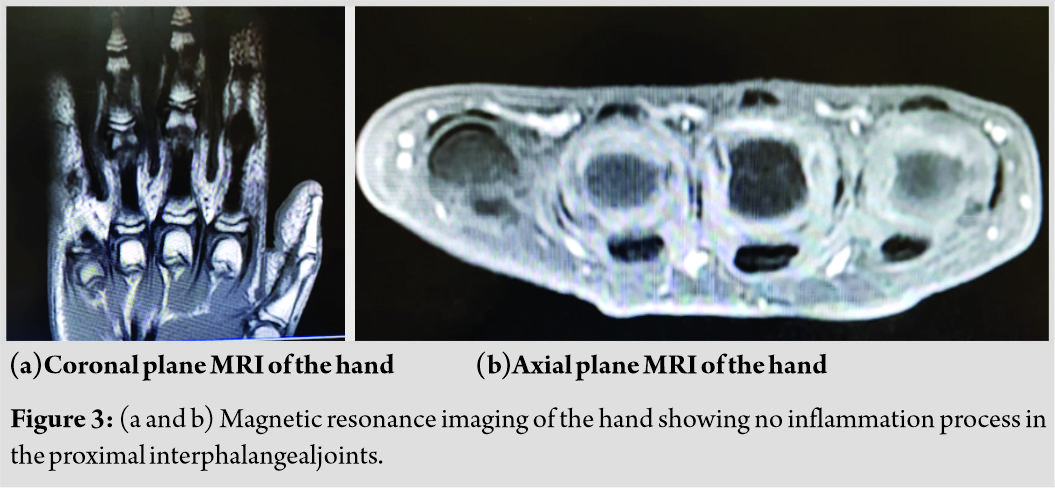[box type=”bio”] Learning Point of the Article: [/box]
Pachydermodactyly is an underestimated entity that is difficult to recognize in clinical practice since it is a diagnosis of exclusion; but a high index of suspicion must be kept in young males with painless, swollen PIP joints associated with hyperkeratosis.
Case Report | Volume 10 | Issue 1 | JOCR January – February 2020 | Page 86-88 | Elias Saidy, Joseph Maalouly, Mohammad Darwish, Chawki Cortbawi. DOI: 10.13107/jocr.2020.v10.i01.1650
Authors: Elias Saidy[1], Joseph Maalouly[1], Mohammad Darwish[1], Chawki Cortbawi[1]
[1]Department of Orthopedic Surgery and Traumatology, Saint Georges University Medical Center, Balamand University, Achrafieh, Beirut, Lebanon.
Address of Correspondence:
Dr. Joseph Maalouly,
Department of Orthopedic Surgery and Traumatology, Saint Georges University Medical Center, Balamand University, P. O. Box 166378, Achrafieh, Beirut – 1100 2807, Lebanon.
E-mail: josephmaalouly2@gmail.com
Abstract
Introduction: Pachydermodactyly is an uncommon or under diagnosed variant of digital fibromatosis. It is a benign disease, described by symmetric proximal interphalangeal (PIP) involvement, progressive swelling, absence of inflammation or pain, and without limitation of function. It has been linked in some cases with psychiatric disorders such as obsessive-compulsive disorder or repetitive mechanical stimulation.
Case Report: We aim to report a case of pachydermodactyly that was diagnosed in a young 17-year-old male patient with painless swelling of the digits mainly at PIP joints with hyperkeratosis that was treated conservatively.
Conclusion: Pachydermodactyly is an under diagnosed and underestimated entity; the recognition of a case in clinical practice can prove to be challenging. A high index of suspicion must be kept at all times when no reason for the swelling is found.
Keywords: Digits, pachydermodactyly, proximal interphalangeal, joint swelling.
Introduction
Pachydermodactyly is an uncommon or under diagnosed variant of digital fibromatosis [1]. As a disease, it is benign in nature, characterized by symmetry, proximal interphalangeal (PIP) involvement, progressive swelling, absence of inflammation or pain, and most importantly lack of limitation in function [2, 3]. It has been linked in some cases with psychiatric disorders such as obsessive-compulsive disorder or repetitive mechanical stimulation [4, 5]. Here, in this paper, we aim to report a case of pachydermodactyly that was diagnosed in a young male patient with painless swelling of the digits mainly at PIP joints with hyperkeratosis that was treated conservatively.
Case Report
We present the case of a 17-year-old male school student, with no significant history of medical conditions, who is active in several sports activities. Initial presentation was 1 year ago for the evaluation of bilateral symmetrical, progressive, and non-painful swelling of the 2nd, 3rd, and 4th digits (Fig. 1).
The patient first noticed the presence of the painless nodules 3 months before presentation. No impairment in the usual activities of daily living or in sports activities was reported. Physical examination at the time revealed symmetrical, non-tender swelling involving the PIP joint, with no limitation or tenderness with active and passive range of motion. The patient had already undergone evaluation by serology for inflammatory and connective tissue diseases that turned out negative. We recommended plain X-rays (Fig. 2) and magnetic resonance imaging (Fig. 3) for further evaluation. Both studies came out revealing no osseous or soft tissue malignancy; also, no radiological evidence of an inflammatory process involving the synovium, the ligaments, the tendons, and the subcutaneous tissues was present. No tissues were sent to the pathology due to the diagnosis being clear.
Discussion
The patient in the case presented in this paper was diagnosed with pachydermodactyly. The symmetrical, progressive, and non-painful swelling of the digits with hyperkeratosis is typical of the condition [6, 7, 8]. The diagnosis was made after ruling out rheumatic, bone, other skin conditions, endocrine problems such as acromegaly and thyroid disease, and tumors. In addition, to ruling out other causes for the case, the clinical presentation, physical examination, and the paraclinical assessment by radiology and serology provided enough evidence to confirm the diagnosis of pachydermodactyly. The disease is very rare in nature with <150 cases reported in literature [9]. As for the treatment, since the patient has no modifiable risk factors that cause mechanical stimulation and no other modifiable risk factors such as psychiatric illness for instance [10] or habitual cracking of the fingers, the patient is scheduled for close follow-up on the wait and see basis, due to the self-limiting nature of the disease [2]. As stated above, literature has only a handful of papers concerning this topic, we thought that it will be beneficial to include a review of this literature to help better characterize and understand this rare pathology. Pachydermodactyly is a diagnosis of exclusion and is on the differential diagnosis of rheumatic diseases. It is considered a dermatological condition and is thought to be related to repetitive mechanical stressors. Characteristic feature is progressive asymptomatic swelling of PIP joints, without attenuation in joint function. Males have a higher incidence of the occurrence. It is important to correctly diagnose the condition to avoid the unwanted side effects of biologic medications.
Conclusion
Pachydermodactyly is an under diagnosed and underestimated entity, the recognition of a case in clinical practice can prove to be challenging. Still, a lot of work needs to be done to raise the awareness of the condition among primary health-care providers, which can help avoid unnecessary immunotherapy and all the associated complications and risk factors such as treatment entitles [2], on the basis of a wrong diagnosis. Establishing a clear diagnosis and a treatment algorithm, in order to properly follow and treat these patients will still be challenging for the time being. This is due to the scarcity of information in the literature concerning the disease, and a lack of large studies, meta-analysis and randomized controlled trial, to help us better understand and treat the disease confidently.
Clinical Message
Diagnosing pachydermodactyly is challenging. It is an underestimated entity and the recognition of a case in clinical practice is difficult since it is a diagnosis of exclusion. A high index of suspicion should be kept in young males with painless, swollen PIP joints associated with hyperkeratosis.
References
1. Perez B, Gomez MI, Sanchez E, Munoz E, Ledo A. Pachydermodactyly: A case report. J Dermatol 1995;22:43-5.
2. Dallos T, Oppl B, Kovács L, Zwerina J. Pachydermodactyly: A Review. Current Rheumatology Reports. 2014;16:1-7.
3. Kopera D, Soyer HP, Kerl H. An update on pachydermodactyly and a report of three additional cases. Br J Dermatol 1995;133:433-7.
4. Bardazzi F, Neri I, Raone B, Patrizi A. Pachydermodactyly: Seven new cases. Ann Dermatol Venereol1998;125:247-50.
5. Erre GL, Piras M, Conti M, Passiu G. Pachydermodactyly. Joint Bone Spine 2016;83:95.
6. Poddighe D, Romano M, Gattinara M, Gerloni V. Pachydermodactyly. J Clin Rheumatol2018;24:37.
7. Tolis K, Stavropoulos N, Mavrogenis A, Spyridonos S. Pachydermodactyly: An unknown entity. J Hand Surg Am 2016;41:e239-41.
8. Barnes LA, Bae GH, Lewis MA, Rieger KE. Pachydermodactyly: Case report including clinical and histopathologic diagnostic pitfalls. J CutanPathol2018;45:949-53.
9. Requena CB, Miot HA, Marques MEA, Miot LDB. Case for diagnosis. Pachydermodactyly. Anais brasileiros de dermatologia. 2014;89:359.
10. Cabanillas M, Monteagudo B, León-Muíños E, Suárez-Amor O. Pachydermodactyly in a young girl: Cutaneous manifestation of a psychiatric disorder? Pediatr Dermatol 2010;27:306-8.
 |
 |
 |
 |
| Dr. Elias Saidy | Dr. Joseph Maalouly | Dr. Mohammad Darwish | Dr. Chawki Cortbawi |
| How to Cite This Article: Saidy E, Maalouly J, Darwish M, Cortbawi C. Pachydermodactyly –A Case Report and Review of Literature. Journal of Orthopaedic Case Reports 2020 Jan-Feb;10(1): 86-88. |
[Full Text HTML] [Full Text PDF] [XML]
[rate_this_page]
Dear Reader, We are very excited about New Features in JOCR. Please do let us know what you think by Clicking on the Sliding “Feedback Form” button on the <<< left of the page or sending a mail to us at editor.jocr@gmail.com






